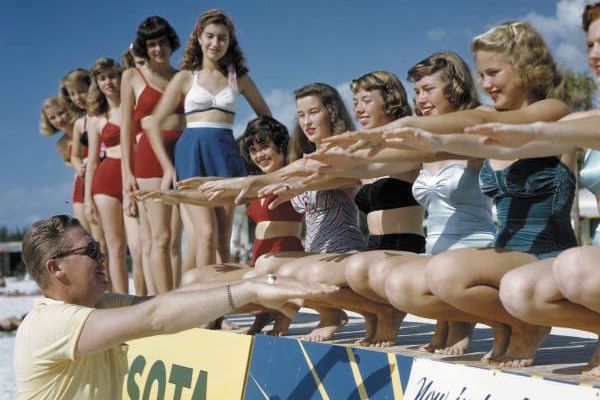How the Sarasota Woman's Club Transformed Our City

Women outside the Sarasota Woman's Club, circa 1915.
Image: Courtesy Photo
At the corner of Palm and Cocoanut avenues, now overshadowed by the sweeping Art Ovation Hotel, sits a wooden building with green awnings, Victorian trim and a faded shingled roof.
It was there, in 1915, that a group called the Sarasota Woman’s Club opened their clubhouse and created what would eventually be the city’s first library. The Woman's Club would go on to become powerful advocates for the beautification of the city, as well as Sarasota breaking away from Manatee County to become its own entity. Its members witnessed history in 1920, when Sarasota women—like most American women—were given the right to vote with the ratification of the 19th amendment. The club became a powerful space for women to wield political influence and hone their leadership skills in a community just beginning to come into its own.
“[The club] was a way for women to band together for self-improvement to become champions of civic improvement and issues that particularly looked to the family, children and education,” says Frank Cassell, an emeritus history professor and university president at the University of Pittsburgh at Greensburg. Cassell has published multiple books about Sarasota’s history. “It was a way for influential women to marshal their numbers and to act in a way that allowed them to influence public policy, particularly in ways that would not have been possible if they were trying to do it on their own,” he says.

Club members lay the cornerstone of the Woman's Club building on Jan. 1, 1915.
Image: Courtesy Photo
In the late 1800s, America's expanding middle class started to come into more economic power. Women were increasingly educated, and larger swaths of people had leisure time. What to do with that time? One of the answers was “self-improvement and a greater influence in public affairs,” Cassell says.
Into this milieu stepped Bertha Palmer, a prominent Chicago socialite and one of Sarasota's early developers. Palmer was a member of the Chicago Woman’s Club and brought that same ethos to the Sarasota Woman's Club, to which she contributed funds to the group and encouraged its official start. Other important club members, like Rose Phillips Wilson, were professional women in their own right. Wilson and her husband started Sarasota’s first newspaper, The Sarasota Times, where Wilson was editor and publisher and wrote frequent editorials. She may have even been the first woman in Sarasota to register to vote.
From early on, the Woman's Club took on a slew of civic projects aimed at developing Sarasota into a full-scale community. In fact, the club began in 1903 as the Town Improvement Society. Early projects included painting trash cans to be placed around the post office and advocating for the creation of sidewalks, according to a report compiled by former Sarasota County historian Ann Shank.
By 1913, more than 60 women were in attendance at the first meeting of the Sarasota Woman’s Club. Three months into its start, the club grew to 107 members, according to a July 1913 article in The Ocala Evening Star. The Sarasota club was part of a growing network of women’s clubs in the state, which that year included 12 new organizations and six waiting to be admitted to the federation.
From the start, the impact of the club's work was clear. A letter from the Sarasota Sun published in The Miami News in May 1913 noted the group’s aesthetic strides thus far. “How did we ever get along without the Woman’s Club so long?” the letter reads. “Already their influence is felt over the entire city. They are going to tackle the cemetery next, and endeavor to make it a place of beauty instead of the barbarously neglected place it now is.”
By early 1915, the club was already laying the first cornerstone of its clubhouse, per newspaper articles, having raised $5,000 for the building and $2,000 for the site. Members were persuasive proponents of their causes. For example, they managed to convince the mayor to institute a citywide workday in which all businesses would close and more than 200 men “with teams of horses” would instead go to the bayfront and build a park. The women, Cassell notes, offered lunch.
“It was terribly important to this young city to have cultural institutions [like the Woman's Club],” Cassell says. “It was a very clear example of seizing on an issue that is of obvious good to the community that they can take credit for—they pulled it together. Almost from the moment Sarasota was settled, women were playing a major role.”
By August 1920, Congress had passed the 19th amendment and it had been ratified by 36 states, giving women the right to vote. In minutes from an April 1920 club meeting, it’s clear that the Sarasota group was already grappling with the change.
“A letter from Mrs. Skinner, the vice-president of the State Federation, was read by the president, urging that classes be held in the clubs teaching citizenship and the proper use of the ballot, as it was probable the amendment would be ratified granting suffrage to women in time for them to vote in the general election, if not at the June primaries," the minutes read.
By 1921, the Sarasota Woman’s Club was undertaking major efforts to educate its members—and the female community at large. A 1920-1921 report from the recording secretary emphasizes its significance. "During the year has come to every woman in the land the right of Citizenship,” the report states. “Has our organization cared, have they realized all that this means? [...] Registration was urged, and the first women in Sarasota to register and vote at the general election were the officers of the club."
That same year also brought with it a major turning point in Sarasota’s history: the creation of Sarasota County. Seeing women as a powerful voting bloc (or at least one it could not ignore), the Sarasota Chamber of Commerce lobbied the women to vote for the formation of the county.
In club minutes from November 1920, Mrs. F.H. Guenther, the club’s first president, noted that the Chamber of Commerce had “plans for the coming year that will be of material benefit to Sarasota.” She urged the passing of a resolution that pledged support to the chamber, which succeeded unanimously, and gave it a contribution of $50. By May 1921, the Florida Legislature had signed a bill allowing for the creation of Sarasota County, hinging on the result of a citizen referendum. A month later, 518 people voted in favor of the bill and 154 voted against it, meaning that Sarasota was officially breaking off from Manatee County.
The exact role the women’s vote played is hard to say, but the mere experience of lobbying a group and exerting political power was important, Cassell says.
“These women’s clubs were training grounds,” he says. “Where else did women get leadership training? You’ve got to have a president, vice-president, treasurer, secretary—how do you learn planning skills and budgeting skills? These clubs were, in a sense, school routes for women. And they did produce a lot of leadership.”
The Woman’s Club’s influence is perhaps most visible in the building that stands on Cocoanut and Palm. That, too, almost became a relic of the past, when it was nearly torn down to become a parking lot. It was arts patron Marian McKenna who saved the building, says Florida Studio Theatre managing director Rebecca Hopkins. She did so for a simple reason: It was the site of her first kiss.
The building itself must be surrounded by some kind of kismet, because it also attracted Richard Hopkins, the theater’s chief executive officer and producing artistic director. He took one look at it and decided it would be the physical theater for what was then a touring company. At its start, it housed 80 folding chairs and had tin cans for lights. McKenna initially rented the building out to Florida Studio Theatre for free, but eventually both parties came to an agreement: Florida Studio Theatre would buy the building for $140,000 if McKenna forgave $40,000. Since 1983, the building has been known as Florida Studio Theatre's Keating Theatre.

The Woman's Club building under construction on Jan. 1, 1915.
Image: Courtesy Photo
The process of working in the building hasn’t been easy. Hopkins jokes that there is only one original piece of wood in the building. But even renovations have revealed hidden fragments of history, like Woman’s Club plaques that were placed in the walls at some point, just waiting to be discovered.
“They just left them in there for history, almost like a time capsule. They knew that eventually someone would open up that wall,” says Hopkins. “We hung those plaques outside of the building in different places.”
In the early 1980s, Florida Studio Theatre leaders made the decision to apply for a spot on the U.S. National Register of Historic Places. By 1985, the designation was added. In some ways, that makes things more difficult—any change to the building has to be approved. But over the course of the application process, research by architect Stuart Barger revealed something else that was special about the building: It was not just a library or a meeting place for the Woman’s Club, but a real cultural hub.
“I spoke with several elderly members of the Woman’s Club who remember the former building,” Barger wrote in a 1983 report. “A common thread that ran through all of the women’s descriptions was that the building was the meeting place in Sarasota. It was used for virtually every social event, according to these women. It was also used for afternoon teas, children’s ballet lessons, etc.”
Sarasota Woman’s Club members still exist to this day, although they no longer meet at the club's original location. The club's president still writes a message on the club's efforts, and its insignia is emblazoned with a simple but powerful slogan: “The good works of life consist of many small units.”



